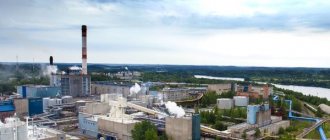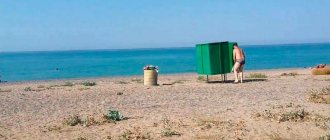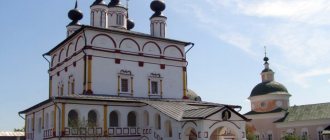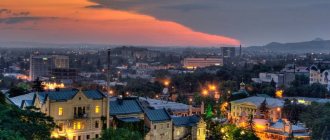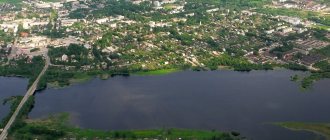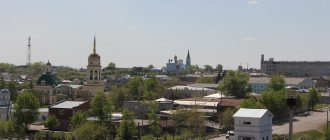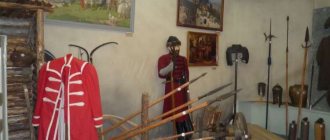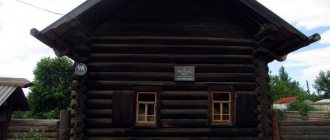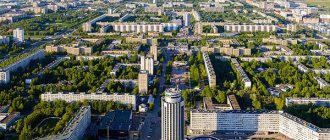Krasnovishersk is the northernmost city of the Perm Territory , famous for its natural beauty and lands that hide in their depths almost the entire periodic table , including gold and diamonds.
However, it is difficult to call the city prosperous - in the early 2000s it lost its city-forming enterprises, and people suffer from unemployment (in 2021, the Krasnovishersky district had the second highest unemployment rate in the country). And the point is not that all earthly riches have been exhausted - gold and unmined diamond placers, decorative marbles, iron and manganese ores still lie in the depths of the Krasnovishersk land. But there is no one to develop them.
Story
Once upon a time, instead of cities, there were small villages and settlements: Morchany, Bahari, Aktim, Vizhaikha and others - now many of them have actually become part of Krasnovishersk.
For the first time, the lands began to be actively developed in the 17th century, when the Krasnoborsky ironworks was built, which did not last long, however.
200 years later, at the end of the 19th century, the Kutimskoye deposit, characterized by a high iron content, was discovered.
Its development began in 1887 - the Kutimsky plant was built, which was later joined by Velsovsky, which was engaged in the production of cast iron. Later, all these enterprises were closed and the buildings were dismantled: the ores turned out to be not as rich as expected.
Industry truly began to develop on the territory of the modern city when, in 1925, the USSR People's Commissariat for Military and Naval Affairs decided to build the Vishera pulp and paper plant (which later became a plant) where Krasnovishersk is located. On October 30, 1931, it was opened, and 11 years later, in 1942, Krasnovishersk officially received city status.
The pulp and paper mill became one of the first enterprises in the USSR, almost entirely built by the hands of prisoners: since 1926, the 4th department of the Solovetsky special purpose camps functioned here, and prisoners were perceived as free labor. This practice would later continue in other places.
The second city-forming enterprise of Krasnovishersk - Uralalmaz, which developed diamond mines - was built in the 1950s; besides it, there were gold mines.
At the beginning of the 21st century, both organizations were closed and declared bankrupt. A few years later, gold and diamonds began to be mined by private companies, small woodworking enterprises operate, but the city-forming enterprises no longer exist.
The population of Krasnovishersk reached its maximum size in 2000 - almost 20,000 people lived here. Now, as at the beginning of the city’s development, this figure is about 15,000.
City on the edge
Krasnovishersk (Perm region) in Soviet times was a small but promising town. It operated a pulp and paper mill, mined diamonds, oil, and operated many other industries. Unfortunately, now all large enterprises have been declared bankrupt. There are no jobs in the city at large enterprises. The city of Krasnovishersk (Perm Territory) is included in the federal program for the development of single-industry towns in Russia.
The development of ecotourism has breathed new life into the city. Tourists from all over the region come here to vacation in Krasnovishersk (Perm region).
origin of name
The first part of the word “Krasnovishersk”, like many other Soviet cities, has an ideological origin, and the second is a derivative of the name of the Vishera River, on the left bank of which the city stands. The Vishera, a tributary of the Kama, is one of the most picturesque rivers of the Urals.
Abundant with shoals, rapids and riffles, it is a favorite place for active recreation for residents of the Perm region and a popular plein air for painters.
It is in the Vishera Basin that diamond deposits are found, and it is here that the infamous Vishlag (aka Vischerlag) was located in the 1930s. In addition to Krasnovishersk, on the banks of the Vishera there are such large villages as Vaya, Vels, Ust-Yazva, Visherogorsk, Ryabinino.
Museums and reserve
Museum of Local Lore. Here visitors will be offered a rich exhibition about the history of the region, the metallurgical plant, and the mining of diamonds and oil. The tragic pages of the history of Vishlag were not ignored here; one of the halls is completely dedicated to it. One of the walls represents the wall of a camp barque. Here you can also see archival documents, photographs and personal belongings of prisoners. And nearby there is a hall dedicated to the memory of Shalamov.
Museum of Nature of the Vishera Reserve. The reserve itself is located in the northeast of the region, and getting there is quite problematic. But for nature lovers, there is a museum in Krasnovishersk, where they tell in detail about the history of the reserve, its flora and fauna. Visitors can see stuffed birds and animals, herbariums of plants growing on the territory of the reserve. And next to the museum there is a small area where plants brought from the reserve are grown, a sort of miniature reserve.
Famous personalities
Not many famous people were born in Krasnovishersk - after all, the city is small. Notable natives include:
- Yuri Aslanyan is a poet, writer and journalist, author of investigative journalism;
- Alexander Zyryanov - dean of the Faculty of Geography at Perm University, Soviet and Russian scientist, popularizer of tourism;
- Irina Fomina is a Russian biathlete, international master of sports of Russia, world and European champion among juniors.
The Perm region is famous for its athletes, and, probably, there will be more famous names in the near future. For example, at the hockey championship in the USA, the judges were greatly impressed by the young Krasnovisherskaya hockey player Elizaveta Dubey, who is predicted to have a future in world sports.
It is impossible to mention Varlam Shalamov, who was born in the Vologda province, but spent several years in prison in Vishlag, an outstanding repressed writer, author of the famous “Kolyma Tales” and many other books.
Transport
There is no railway. The nearest passenger station is in Solikamsk
There are regular bus services to Perm, Solikamsk, as well as to towns and villages subordinate to the Krasnovishersky urban district (Vaya, Visherogorsk, Verkh-Yazva, etc.).
There are two bus routes in the city:
| Route | Starting point | Final destination |
| 1 | st. Neftyanikov | st. Victory |
| 2 | Naberezhny village | UZD village |
Previously, route 3t “st. Neftyanikov - Naberezhny settlement"
There is an inactive airport 1 km from the city.
Sights of Krasnovishersk
Krasnovishersk does not look like an ancient town, like some other cities in the region. It was created in a difficult time for the country and did not have time to acquire a host of legends; In addition, now, due to the bankruptcy of two city-forming enterprises, it is in a state close to decline.
The population is decreasing, its well-being is suffering, and young people are leaving the city. However, there is a lot to see and do here.
Museum of Local Lore
Address: Dzerzhinsky street, 4
The mission of the Krasnovishersky Regional Museum of Local Lore is to educate the population in various fields. There are exhibitions dedicated to history (in particular, the Great Patriotic War), geography, science and technology, animal art, engineering and inventions.
The permanent exhibition is constantly enriched with temporary projects; there is a social cinema hall, positioning itself as a club of interests, where you can watch films dedicated to the nature and history of the Urals, and discuss popular social issues.
Exhibition hall of the regional museum of local lore
Address: Dzerzhinsky street, 4
The exhibition hall of the museum houses a permanent graphic and painting exhibition, which is a collection of more than 100 paintings.
There are exhibitions dedicated to photography, arts and crafts (in particular, folk art) and children's drawings. The museum cooperates with the Association of Artists of Vishera “Istok”.
Monument to Varlam Shalamov and victims of political repression
Address: Dzerzhinsky street, 6A
A memorial stone with a portrait of Varlam Shalamov was installed in 2007. In his youth, the writer joined the left opposition, for which he was arrested in 1929, and spent 3 years in Vischerlag.
As an educated prisoner, he participated in the construction of the Berezniki chemical plant, and later was the head of the accounting and distribution department of the Berezniki branch of the Vishlag. He was arrested a second time in 1937 and sent to Kolyma, where he spent a total of 16 years.
Shalamov’s first term was reflected in the collection “Vishera. Anti-novel,” published after the author’s death.
Memorial complex to fallen Krasnovisher soldiers
Address: Dzerzhinsky street
The monument was erected in 1974 in memory of the fallen soldiers who went to war from all over the USSR, including the Perm region.
It is a stele with the figure of a soldier rising against its background, decorated with battle bas-reliefs. The stele lists 797 names of Krasnovisher soldiers who did not return from the fronts.
Fountain "Vetlan, Polyud and Vishera"
Address: Central Square
The sculptural group depicting a girl and two men is a reference to the legend according to which two heroes - Polyud and Vetlan - fought for the heart of the beautiful Vishera, and she did not give preference to anyone and loved both.
The battle lasted 6 days and nights, but the strength of the young men was equal, and, tired, they sat down on the ground and turned into stones; The white light without them became unkind to the girl, and she became a river flowing between them.
The fountain is the “story center” of Krasnovishersk, a favorite place for walks for townspeople and tourists. On the Internet you can find many photographs of this place and illustrations - in particular, children's drawings - dedicated to it.
Peter and Paul Church
Address: Morchanskaya street, 102
The Church of Peter and Paul in Krasnovishersk was built at the expense of parishioners at the turn of the 19th and 20th centuries. There is a legend according to which two Cossacks, Peter and Pavel, first built a chapel on this site.
Which later became a full-fledged church. In 1912, at the expense of the Cherdyn district zemstvo, a Sunday school began to function here.
In 1931, the building belonging to the church was given over to the collective farm granary, but in 1955 it was reopened as a temple and consecrated. Now the Peter and Paul Church is operational; parishioners can attend services on Saturdays, Sundays and church holidays.
Things to do
In the Vishera Nature Reserve, tourists can visit three routes. All are accessible only with a formalized permit, which will be checked by inspectors, and with an escort. Independent placement of objects in a specially protected natural area is prohibited.
All routes are multi-day. The duration of the trek is from two to seven days. You can spend the night at cordons and guest houses, of which there are four in the reserve: guest houses “Vels” and on the tract 71 quarters, cordons Lypya and Round Hole. In each of them you can pay and take a place in the house or sit next to the tent. Setting up a tent in the reserve is also a paid service.
Cordon “Round hole”, © Petr Filonenko
The Tulym ring is the longest route of the reserve. It runs along the Chuvalsky ridge and the southern spur of the Tulym stone, including access to the highest point of the reserve and the entire Perm region. Tourists walk the first part of the journey, and from the Lypya cordon they raft back by boat.
Another route is laid along the southern border of the Vishersky Nature Reserve and is designed for approximately 5 days. It includes a passage along the so-called “French” path, and then access to the Wels River. The group rafts along it to the village of the same name.
The “Along Chuval” route is the shortest and takes two days. The main attraction that tourists will see is the Chuval plateau.
How to get there
The route from all cities, except the northern ones, passes through the regional center. The distance on the map from Perm to Krasnovishersk is just under 300 km; You can also get there by car from:
- Chusovoy;
- Bereznikov;
- Kungura;
- Tchaikovsky;
- Solikamsk;
- Yekaterinburg (although you will have to travel 600 km).
There is a constant transport connection between Krasnovishersk and Solikamsk, Perm - there are regular buses.
Population
| Population | ||||||||
| 1959[5] | 1967[6] | 1970[7] | 1979[8] | 1989[6] | 1992[6] | 1996[6] | 1998[6] | 2000[6] |
| 15 207 | ↗16 000 | ↘14 944 | ↗15 917 | ↗18 700 | ↗19 200 | ↗19 400 | →19 400 | →19 400 |
| 2001[6] | 2002[9] | 2003[6] | 2005[6] | 2006[10] | 2007[10] | 2008[11] | 2009[12] | 2010[13] |
| ↘19 300 | ↘18 260 | ↗18 300 | ↘17 800 | ↘17 700 | ↘17 500 | ↘17 400 | ↘17 320 | ↘16 099 |
| 2011[6] | 2012[14] | 2013[15] | 2014[16] | 2015[17] | 2016[18] | 2017[19] | 2018[20] | 2019[21] |
| ↗16 100 | ↗16 111 | ↗16 127 | ↘15 917 | ↘15 733 | ↘15 644 | ↘15 587 | ↘15 359 | ↘15 022 |
| 2020[1] | ||||||||
| ↘14 836 |
As of January 1, 2021, in terms of population, the city was in 788th place out of 1115[22]cities of the Russian Federation[23].
The current demographic situation in the city is characterized by a decrease in the birth rate, a transition from expanded to simple reproduction of the population, progressive aging of residents and an increase in mortality (modern growth factors: high social tension and the problem of alcoholism). The decline in production and the associated lack of jobs is forcing the younger generation to leave their homes. Age structure of the population: 0-15 years - 27.6%, retirement age - 13.9%, working age - 58.5%. The average age of the population is 33.4 years. The average annual number of workers and employees in industry was 3017 people, more than 40% of workers are employed in the forestry sector.
National composition
Useful tips for tourists
- In small towns, museums and exhibitions are not always open every day. It is recommended that before visiting, you call the numbers listed on the websites to find out exactly when you can arrive. Often special excursions are organized for tourist groups.
- In the summer, there is a particularly romantic way to get to Krasnovishersk - along the river on a boat coming from Solikamsk. You can go by river to the pier of the Kama Shipping Company, from there it is only 2 km to the city.
Climate
- Average annual air temperature - −0.3 °C
- Relative air humidity - 74.9%
- Average wind speed - 3.2 m/s
| Climate of Krasnovishersk | |||||||||||||
| Index | Jan. | Feb. | March | Apr. | May | June | July | Aug. | Sep. | Oct. | Nov. | Dec. | Year |
| Average temperature, °C | −15,6 | −14 | −7,4 | −0,7 | 7,6 | 14,5 | 17,1 | 12,8 | 6,9 | −0,5 | −10,3 | −14,6 | −0,3 |
| Source: NASA RETScreen Database |
Reviews
Alena, village Zolotanka
We went on an excursion to Krasnovishersk. Liked! It’s probably better to choose a tour with a bus escort, because you get tired of running around the sights, even though it’s a pleasant tiredness.
Igor, village Mutiha
We got there on our own. The town is small and not particularly interesting for tourists, but it’s even better - there are fewer people. The main square was found based on the description of the fountain, a very impressive sculptural group.
Anna, Gagarin
It’s difficult to live in Krasnovishersk, it seems to me that it’s a small town, there’s very little work. But what nature! People come here from all over the region.
Social sphere
The city's energy supply is provided by boiler houses. Heating networks and substations of the Krasnovisherskaya - Perm energy system, and gas supply with liquefied gas from the Raigaz reservoir through a network with a length of 6.5 km.
Cellular operators: Tele2, MTS, Beeline, Megafon, Rostelecom. Landline phones: Rostelecom. Internet using ADSL, GPON technology: Rostelecom, NPO "Impulse"
In 1980, the People's Museum of Local Lore was opened.
The city is provided with preschool institutions and hospitals.
Since the summer of 2012, a general city movement “Drug-Free City” has been organized.
Mass media
Printed publications
- Red Vishera
Radio
| Frequency | Name |
| 103.2 | White radio |
| 103.7 | Sol FM |
| 106.3 | Radio Russia/Perm |
A television
| Frequency channel | Multiplex |
| 34 UHF channel | The first multiplex RTRS-1 |
| 43 UHF channel | Second multiplex RTRS-2 |
- "Vishera TV", cable television, 75 DVB-C channels
Ecology
The source of air pollution is oil and gas production: within a radius of 10 km from oil and gas wells, the maximum permissible concentration is up to 0.9. The sanitary and hygienic condition of the soil cover and vegetation can be considered favorable. Significant damage is caused to the forest fund due to timber harvesting by numerous sawmills. There is a lot of garbage left in the forest, and virtually no restoration work is being done. Omissions in law enforcement and management activities of local authorities contribute to the degradation of the environment, which in the recent past was characterized by extraordinary beauty, an abundance of mushrooms and berries, and a diversity of flora and fauna. Also, the quality of the Vishera River does not correspond to the maximum permissible concentration for 2014: it exceeds 5 maximum permissible concentrations for manganese, and exceeds 3 maximum permissible concentrations for iron, water quality class 3 “a” (polluted). Birch coal is being harvested in the city, as a result of which smog with an unpleasant odor can occur in the city in calm weather.

